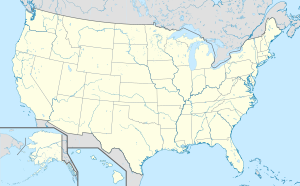Rogue River Bridge
Coordinates: 42 ° 25 ′ 38 " N , 124 ° 24 ′ 47" W.
| Rogue River Bridge | ||
|---|---|---|
| Official name | Isaac Lee Patterson Bridge | |
| use | Road bridge | |
| Convicted |
|
|
| Crossing of | Rogue River | |
| place | Gold Beach - Wedderburn, Oregon | |
| construction | Concrete arch bridge | |
| overall length | 578.5 m | |
| width | 10 m | |
| Longest span | 7 × 70.1 m | |
| start of building | 1930 | |
| completion | 1931 | |
| opening | May 28, 1932 | |
| planner | Conde McCullough | |
| location | ||
|
|
||
The Rogue River Bridge , officially the Isaac Lee Patterson Bridge , is a road bridge that spans US Highway 101 between Gold Beach and Wedderburn in Curry County in Oregon , USA, over the Rogue River . It is the last bridge over the river before it flows into the Pacific Ocean, 1.8 km away .
Opened in 1932, the concrete arch bridge with its Art Deco elements is an important example of the bridges designed by Conde McCullough , then head of the Oregon Roads Department.
It is named after Isaac Lee Patterson , who was Governor of Oregon from 1927 to 1929.
The Rogue River Bridge was added to the list of Historic Civil Engineering Landmarks by the American Society of Civil Engineers (ASCE) in 1982 and to the National Register of Historic Places in 2005.
description
The bridge is 579 m long and has a width of 8.2 m, two lanes and a narrow walkway on both sides. The structure is a total of 10 m wide. The bridge consists of a series of seven arches with pillar spacing of 70.1 m. The arches each consist of two slender arched ribs that are stiffened with cross braces. In order to avoid shrinkage cracks after the removal of the falsework , the arch ribs were pressed apart in the crown joints shortly before fitting using a system developed by Eugène Freyssinet and thus pressed into a higher arch curvature and the gap was closed with concrete. This was causing the sheets during the subsequent shrinkage of the concrete absenkten again and accepted the proposed form. McCullough had the presses necessary for this process, which was used for the first time in the USA, with Freyssinet's support from France.
The roadway is elevated with five savings arches on the two shoulders of each arch. The saving arches are lavishly designed with profiled double pillars, bases, indicated capitals and a stepped front rim. The cantilever beams of the cantilevered walkways and the balustrades are designed in a similar manner .
The row of arches is framed by massive pillars, which protrude as stepped towers over the bridge deck. These pillars are followed by nine short arches on each of the two bank slopes on high, narrow pillars, which connect to the road about 20 m above the river.
The bridge was extensively renovated between 2001 and 2004 after it had suffered greatly from the salty air at its location.
Web links
- Bridge at Mouth of Rogue River, Spanning Rogue River on Oregon Coast Highway, Gold Beach, Curry County, OR on: Historic American Engineering Record (HAER) (with photos and detailed description)
- Robert W. Hadlow: Rogue River Bridge No. 01172. National Register of Historic Places, Registration Form dated June 30, 2004 (PDF; 1.7 MB)
Individual evidence
- ↑ Rogue River Bridge No. 01172 in the National Register Information System. National Park Service , accessed May 15, 2017


